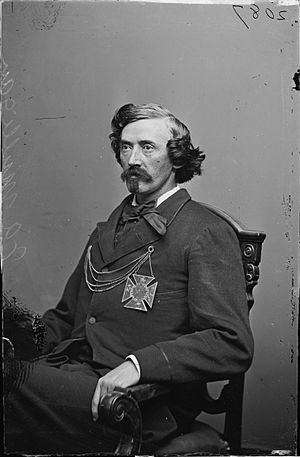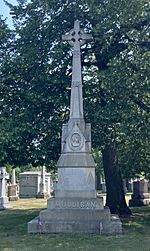James A. Mulligan facts for kids
Quick facts for kids
James A. Mulligan
|
|
|---|---|
 |
|
| Born | June 30, 1830 Utica, New York |
| Died | July 26, 1864 (aged 34) near Winchester, Virginia |
| Place of burial |
Calvary Cemetery, Evanston, Illinois
|
| Allegiance | United States |
| Service/ |
United States Army |
| Years of service | 1861 - 1864 |
| Rank | |
| Commands held | 23rd Illinois Volunteer Infantry Regiment Camp Douglas (Chicago) |
| Battles/wars | American Civil War |
James Adelbert Mulligan (born June 30, 1830 – died July 26, 1864) was a brave soldier who fought for the Union Army during the American Civil War. He was a colonel leading the 23rd Illinois Volunteer Infantry Regiment. After his death, he was honored with the rank of brevet brigadier general. Colonel Mulligan was known for leading his troops at the First Battle of Lexington. He also showed great courage in other battles before he was killed in action near Winchester, Virginia.
Contents
Life of a Civil War Hero
Early Years and Training
James Mulligan was born on June 30, 1830, in Utica, New York. His parents had moved there from Ireland. Sadly, his father passed away when James was a young boy. His mother later remarried and moved to Chicago, Illinois, with James.
James went to St. Mary's on the Lake College in North Chicago. From 1852 to 1854, he studied law. In 1856, he became a lawyer. He also joined the "Chicago Shield Guards" as a second lieutenant.
Forming the Irish Brigade
When the Civil War began in 1861, James Mulligan quickly formed a group of soldiers. This group was called the 23rd Illinois Volunteer Infantry Regiment. People in Chicago knew them as the "Irish Brigade." This unit included the "Chicago Shield Guards" that Mulligan was already a part of.
In September 1861, Colonel Mulligan led his troops towards Lexington, Missouri. They heard that a key river town would be attacked. It was going to be attacked by the pro-Confederate Missouri State Guard.
The Battle of Lexington
The First Battle of Lexington started on September 13, 1861. It is sometimes called the "Battle of the Hemp Bales." About 12,500 Confederate soldiers began to surround Mulligan's small group. Mulligan had only 3,500 soldiers. They were dug in around the town's old Masonic College.
On September 18, the Confederate army attacked Mulligan's defenses. The attack failed. Cannon fire continued through September 19. On September 20, Confederate soldiers used large bales of hemp. They soaked the bales in the Missouri River. They rolled these bales in front of them for protection. This helped them get closer to Mulligan's headquarters. By 2:00 p.m., Mulligan had to surrender.
The battle resulted in 64 soldiers dead and 192 wounded on both sides. The Confederate general, Sterling Price, was very impressed by Mulligan. He admired Mulligan's brave actions during and after the battle. General Price even offered Mulligan his own horse and buggy. He made sure Mulligan was safely returned to Union lines.
Leading Camp Douglas
From February to June 1862, Mulligan was in charge of Camp Douglas. This camp in Chicago was a place for prisoners of war. It was first built to train Union soldiers. But it became a prison camp for captured Confederate soldiers. This happened after the fall of Fort Donelson in February 1862.
Many prisoners at Camp Douglas suffered from illness. Mulligan tried hard to make conditions better for the prisoners. He faced challenges like not enough money and slow paperwork. His efforts to improve the camp might have been influenced by how well General Price treated him after his capture.
Building Fort Mulligan
Between August and December 1863, Mulligan oversaw the building of Fort Mulligan. This was an earthworks fort in Grant County, West Virginia. Earthworks are defenses made from dirt.
Later, Confederate Major General Jubal Early praised Mulligan's engineering skills. He said the fort was very well built. Fort Mulligan is still one of the best-preserved Civil War forts in West Virginia. It is now a popular place for tourists to visit.
The Battle of Leetown
On July 3, 1864, just three weeks before he died, Mulligan showed great bravery. This was during the Battle of Leetown, in Leetown, Virginia. Union troops were retreating from Confederate forces. General Franz Sigel asked Mulligan to hold Leetown for as long as possible. This would buy time for other Union forces to gather.
Mulligan had only two regiments of infantry, five cannons, and 1,000 cavalrymen. He faced six Confederate infantry divisions and many cavalry and artillery units. He was told not to expect any help. He had to hold the line as long as he could. Then, he had to retreat slowly while fighting.
The battle started at 6:00 a.m. Mulligan led his small force out of their trenches. He pushed back the attackers. Even though the Union forces were outnumbered, Mulligan held the main Confederate army at Leetown all day. He then slowly retreated. Mulligan continued to fight General Early's forces all the way to Martinsburg, Virginia. This gave valuable time for Union commanders to bring their troops together.
A Hero's Final Moments
On July 24, 1864, Mulligan led his soldiers into the Second Battle of Kernstown. This battle was near Winchester, Virginia. Late in the afternoon, Confederate forces attacked Mulligan's 1,800 soldiers. They attacked from behind Opequon Church.
Mulligan's troops held off the attack for a short time. But then, another Confederate general, John C. Breckinridge, attacked from the side. Sharpshooters also attacked Mulligan's right side. Now, Union soldiers were surrounded on three sides. Their battle line broke apart.
With Confederates closing in, Mulligan ordered his troops to pull back. As he stood up on his horse to encourage his men, Confederate sharpshooters shot him. Mulligan's soldiers tried to carry him to safety. But the heavy enemy fire made it impossible. Mulligan knew the danger his men were in. He famously ordered: "Lay me down and save the flag." His men sadly followed his order.
Confederate soldiers captured Mulligan. They carried the badly wounded colonel to a nearby home. He died there two days later. He was buried at Calvary Cemetery in Evanston, Illinois.
See also
- List of American Civil War brevet generals (Union)
- Lexington Historical Museum


